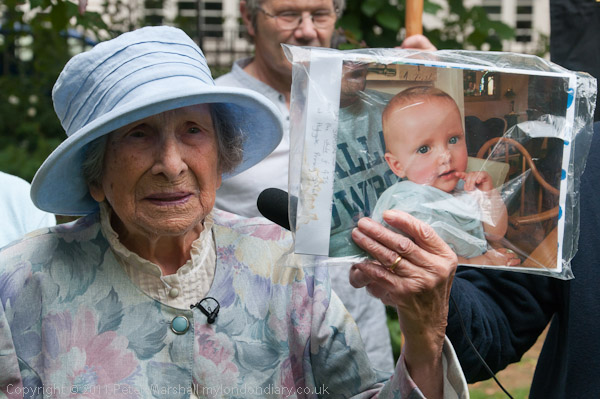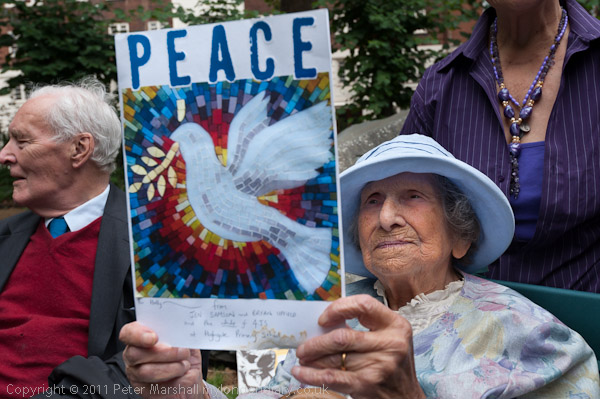As a way of introducing ourself to the audience in the panel discussion on street photography, the three of us (myself, Mike Seaborne and Polly Braden) were asked in advance by chairman Stephen McLaren each to choose our two favourite pictures from the show at the Museum of London and to start the event by talking about them for five minutes. Here are my views about what they said, as well as what I meant to say but quite likely didn’t quite.
Mike Seaborne, one of the curators of the show, chose one very well-known work, a photography by John Thompson from his work with sociologist Adolphe Smith published in monthly parts as Street Life in London in 1876-7. You can see a fine selection of them on the Spitalfields Life site, which also has an entire article about the picture chosen by Mike, of Hookey Alf of Whitechapel, accompanied by the interpretation by Smith and some recent discussion. Certainly this is a photograph I admire and work that I’ve written and talked about in the past.
His other choice was an anonymous picture of a woman walking in Hyde Park, which he compared to the images by Lartigue of well-dressed women strolling in the Bois de Boulogne. Although there was a superficial resemblance, I couldn’t really agree in this case with his argument which seemed to be that Lartigue’s pictures are seen as more important because he later became a well-known photographer. I’m not a great fan of Lartigue, but his pictures – such as the woman with two dogs here – show so much more flair and style than the mildly interesting image we were looking at. I have rather more sympathy with the general point Mike was making but perhaps this is not a particularly good example.
Polly Braden‘s choices were a rather nice pictorial image made in 1930 by Hans Casparius (which I can’t find on line) of two women seen from a moderate distance caught by light passing on a Westminster street corner. It was an image that in its use of light reminded me of some of her work, as well as some of my first pictures of London in the 1970s. The women seem to be simply passing, but somehow the lighting creates a relationship between them.
Her second was well-known to me, one of the relatively few images made by Margaret Monck, who was a part of the documentary movement of the 1930s and who I wrote about elsewhere some years ago, along with her mentor, Edith Tudor-Hart (the sister of the oldest living photographer in this show, Wolf Suschitzky, who as well as being a fine photographer was also the most effective of Soviet spies in the UK, recruiting Bertie Broda who worked on the Manhattan atomic bomb project, passing the US atomic secrets to her and so to Russia – as well as Philby and others.)
The picture chosen, taken in Westminster shows a wealthy woman stopping to put a coin into the hat held by the seated figure of a disabled ex-serviceman at the edge of the pavement. Although Monck ‘dressed down’ to take her Leica on expeditions to the poorer wastes of London, I can’t look at this picture without perhaps unfairly mirroring her similarly dressed to the woman in it, holding her Leica to her face and attracting the attention of the man on the steps in the background of the picture. I wonder too if she had been walking together with this woman and had set up this image rather than simply coming across the event on the street. Not that this alters the fact it is a finely seen and composed picture, then man’s walking stick leaning against the wall at left, and a man who appears to have no cares in the world, a flaneur in flannels and sports jacket approaching from the bottom of the stairs. But perhaps the most intriguing feature are the two large landscape paintings at the left of the image. Were these perhaps put there by the beggar to attract the attention (and largesse) of passers by, or in some way to avoid prosecution for begging under the Vagracy Act? Like many photographs it is often the unexplained details that intrigue.
I had been the first to speak and my first choice was Outside Claridges Hotel, Mayfair, 1967 by Jerome Liebling. Probably my favourite image in the show, it also seems to me to represent the very heart of street photography. As I said at this point, the four of us on the platform would probably have very different views of what street photography was (it was a topic our chair had warned us to avoid) but I felt we might agree that it’s golden age was in New York around the Second World War. Liebling, who died this July age 87, studied photography with Walter Rosenblum and was a member of the New York Photo League in the late 1940s working in the city with many of the other great street photographers of the time – including Helen Levitt, Sid Grossman, Morris Engel, Ruth Orkin, Lou Stoumen and Dan Weiner.
Liebling has caught a moment of confrontation between the two main figures in the image, evidenced by their gaze and body language. It isn’t clear exactly what is happening, with a small crowd (including I think another photographer) and a policeman gathered to watch, but it is a picture very much about class differences and class uniforms, with the added twist that the doorman holding the door of the car is – like all doormen – in reality a low-paid employee dressed in a uniform that is a kind of parody of the upper class dress of a previous era.
At about the time this image was made, another photographer from the New York school had come to this country and settled here. I’ve recently been helping John Benton-Harris working on some of his pictures of the English for a show in Poland next month and a book, from a series he calls ‘Mad Hatters’ and into which this image would rather nicely fall.
John too is a link to the second image I chose to talk about, by Tony Ray-Jones, who like him studied (although in New York rather than New Haven where Tony was then) with the great designer Alexey Brodovitch. Others of his students included Richard Avedon (who hosted many of the classes in his studio) Diane Arbus, Lisette Model and arguably the greatest master of street photography, Garry Winogrand.
When Ray-Jones returned to England, he began working on a book on the English, and although the picture in the Museum’s show is perhaps not one of his best it is in some respects typical, a very recognisable example of one of the ways that he made pictures. When I first saw it on the museum wall, I was very doubtful about its caption, ‘Notting Hill, c 1967’. Although obviously taken at some kind of street event – you can see the reflection of small crowd in the large window behind the figures, it didn’t look like Notting Hill, and certainly it wasn’t the carnival, very small in those early years and attracting an almost entirely West Indian audience.
The poster for the social photographers ‘Milvain Studios’ also worried me, as Milvain is a village in Northumberland, and although the name might not be connected it did seem more likely that this was perhaps Newcastle or somewhere around there rather than London. The captions on Ray-Jones’s photographs are notoriously inaccurate, as most were added after his early death in 1982 by his widow and photographers who had worked with him – including Benton-Harris who printed much of his work and who loaned the print to the museum for the show. Many of those in the posthumous ‘A Day Out’ published the year after his death are incorrectly captioned.
Although Ray-Jones took a number of fine pictures in London, with my favourite being a gloriously surreal street corner in Brook St, with one man emerging from a hole in the pavement and two others engaged on the ends of a short length of tubing, one on his knees on the pavement and another holding some kind of device on its other end up in the air, apparently the Museum of London has none of his prints. You can see a good selection of several hundred of them – though not including the ‘Notting Hill’ image – at the Science & Society Picture library* – and can buy reasonably priced good quality inkjet prints for £15 each. I own several of them, as well as one rarer example actually printed by the photographer. The inkjets are better prints.
The print in the show reminded me a little of some of his better-known images but one that somehow didn’t quite make it. I wasn’t surprised when curator Mike Seaborne told me it had been taken in Durham, and the actual site has been identified thanks to some real detective work by a police officer who visited the show and was able to identify the uniform of the policeman as being from that city, and more than that sent Mike the link to a Street View image of the shop at right, still much the same, though Milvain Studios and their advert are long gone. Ray-Jones went to Durham for the miner’s Gala, and Benton-Harris also has some fine images from the same event.
I hadn’t known it was taken in Durham, and hadn’t chosen it because it broke one of the rules established by the curators by being taken outside London. (There were a few others taken a little outside the London boundary in the surrounding counties such as Surrey.) In fact it broke a second of their rules also, as it was taken at an organised event, if not the one they had assumed. Perhaps if the show as hoped travels abroad it could be replaced by one of his better London images which truly fit their criteria and I’m sure Bradford would oblige. The best prints of Ray-Jones’s work by a long chalk are those made on bromide paper from scans for his show there are few years ago, and I imagine the inkjets on sale come from the same scans.
But apart from being a not bad photo, it was also for me a link to a photographer who played an important role in bringing street photography as we knew it to Britain. It was at Ray-Jones’s prompting (aided by John Benton-Harris) that editors Bill Jay and later Peter Turner published the work of many American photographers in the magazine Creative Camera that really changed our view of photography here, and photographers influenced by him – including Martin Parr – gave British photography a new impetus and direction.
I didn’t get to say quite all that in the five or so minutes I had to talk about the two pictures on Wednesday night, and certainly what I did say would not make quite so much sense, talking off the cuff (although I did notes on paper.) I’m happier with the extra time to reflect that comes from writing – or with giving a lecture, though a discussion like we had was perhaps more entertaining.

Rather fewer May Queens in 2008 than when Tony Ray Jones photographed this event 40 years earlier
* Where some of the pictures are still incorrectly captioned. That large group of May Queens for example is at Hayes, Kent and not Sittingbourne. It was an image that prompted me in the early years of this century to begin my own extensive work on May Queens. I took the picture above working on behalf of that year’s London May Queen in the centre of this group.


